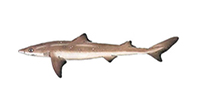Thank you for visiting the Seafood Selector. EDF is planning a new approach to providing information to consumers about good seafood choices. Please come back soon for updates.
Shark

Spiny dogfish shark
Recommended servings per month
| Contaminant | Men | Women | Kids 6-12 | Kids 0-5 | |
|---|---|---|---|---|---|
| Spiny dogfish (US) | Mercury | < 1 | 0 | 0 | 0 |
| Longfin mako | Mercury | < 1 | 0 | 0 | 0 |
| Blacktip shark | Mercury | < 1 | 0 | 0 | 0 |
| Common thresher shark | Mercury | < 1 | 0 | 0 | 0 |
| Shortfin mako (HI, CA) | Mercury | < 1 | 0 | 0 | 0 |
| Spiny dogfish (Canada - Pacific) | Mercury | < 1 | 0 | 0 | 0 |
| Spiny dogfish (Canada - Atlantic) | Mercury | < 1 | 0 | 0 | 0 |
Eco details:
Most shark species are severely depleted. The main reasons for their precipitous decline are:
- They are caught accidentally by the thousands and discarded as waste by tuna and swordfish longline fishers.
- There is strong demand for their fins in Asia.
- Most sharks mature slowly and have few offspring.
Spiny dogfish are especially vulnerable to overfishing, since they have the longest gestation period of any vertebrate (two years).




